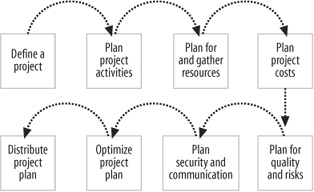Lesson 1.1. Planning the Project Figure 1-1. Steps in planning a project. 
Perhaps the most difficult step in Project 2003 is the first one: planning the project. Planning requires constant research and editing. In fact, you may find that the planning stage of a project doesn't really end until you're finished with the project. So how can you prepare yourself, and what can you do to make this process pain-free? The illustration in Figure 1-1 shows a common progression of steps to take when planning a project, depending on the type of project you're tackling. Table 1-1 describes these steps in further detail. It is important to note, however, that these steps are merely guidelines for planning a project and will change depending on the type of project you are doing. Table 1-1. Planning StepsStep | Description |
|---|
Define a project | Initiate the project: Clearly identify the purpose and goals of the project; estimate when key resources will be available to work on the project; make backup plans for key project components; and identify the project's constraints and limitations, such as the schedule, resources, budget, and scope. Start a project file: Create the project's file and set the project's properties, such as working time (i.e., Monday through Friday, 8 a.m. to 5 p.m.). Define project deliverables: Define the actual product or service that meets the project's objectives. | Plan project activities | Define phases and create a task list: Enter the tasks required to complete the project, define the project's phases, and add any supporting information to the task. Show the project's organization: Structure the tasks into their respective phases, and create a hierarchy of summary tasks and subtasks. Organize the project into master project and subproject files: Complete a large project (master project) by completing smaller projects (subprojects). Estimate task duration: Estimate how long a task will take to complete, considering nonworking time. Fine-tune duration with the Task Calendar. Set task dependencies and constraints: Identify and link tasks that affect the progress of another task. Create interrelationships with projects: Identify tasks in the master project that are dependent upon tasks in subprojects. | Plan for and gather resources | Estimate resource needs: Compile a list of all the resources you will need, and change the project duration as necessary. Also get input from others involved in the project. Enter resource information and set working times: Update information about the resources, and set the hours they will work. Share resources among projects: Sharing resources can help make it easier to manage a project's progress. Assign resources to tasks: Assign resources to specific tasks and the amount of time they are expected to work on the task. | Plan project costs | Estimate costs: Research previous projects to estimate how much a task will cost. Define and share cost information: Prepare a budget, establish a baseline plan, and share the information with the parties involved. Prepare to manage costs: Set a fiscal year for the project, plan how to track and manage costs, and track the cash-flow plan. | Plan for quality and risks | Plan for quality: Define quality standards and determine how quality affects the overall scope of the project. Identify and plan for risks: Research reliable resources, identify risks, and create a plan of action to handle risk events should they occur. | Plan security and communication | Set up methods for communicating project information: Decide and establish a procedure for how you want to share project information with everyone involved. Protect project information: Depending on the communication resource you use, set passwords, specify security settings, etc. | Optimize a project plan | Optimize the project plan to meet the finish date, plan for resources, and complete the project within its budget constraints. | Distribute a project plan | Depending on how you share and communicate the project's information, distribute the project's plan online or in printed format. |
Remember, you still have to plan the project yourself. Microsoft Project 2003 can only help you record and keep track of all the tasks, resources, and costs within it. |
